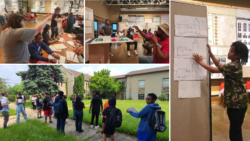


How do you get students excited about pursuing a career in architecture? Provide them with a hands-on opportunity to design projects, interact with industry mentors, and learn what it’s like and what it takes to become an architect (and make it a free program so that all students can participate).
That’s the purpose of Project Pipeline, an initiative of the National Organization of Minority Architects (NOMA) to introduce more minorities to the architecture, engineering, and construction (AEC) industry. This past summer, members of NOMA Detroit once again hosted free Project Pipeline architecture day camps in the Detroit and Kalamazoo regions, for students ages 11 to 18. Twenty-five students participated in the Kalamazoo camp, and 27 in the Detroit camp. The Kalamazoo camp had nine repeat students (and one of the students was in his 3rd year in the program), while the Detroit camp had six repeat students.
 NOMA Detroit has hosted Project Pipeline camps in Michigan for the past nine years.
NOMA Detroit has hosted Project Pipeline camps in Michigan for the past nine years.
The camp is a multi-year recipient of MAF’s Damian Farrell Architecture Awareness Grants (and, starting this year, MAF’s Educational Awareness Grant program).
Project Pipeline serves a diverse population of students, all of whom are underrepresented in the design field, and better prepares them for college and life beyond. While Project Pipeline is open to all students, enrolling minority students in the program remains the primary focus.
“Better design is birthed from diverse backgrounds,” said designer Sara Timberlake, NOMA, LEED Green Associate and Youth Outreach Chair for NOMA Detroit. “Our profession has been trying to push the needle towards diversity forward for over 50 years. Programs like Project Pipeline help create momentum and prepare the foundation that helps future designers thrive.”
“We are very proud of the growth of the Kalamazoo Project Pipeline camp,” said designer Hayward Babineaux, Assoc. AIA, NOMA, and Director of Project Pipeline’s Kalamazoo camp. “We started with ten students our first year. Now in our sixth year, we had 25 students participate. Additionally, Western Michigan University continues to provide us space to host the camp and has a display of the students work. So the word is definitely getting out about the camp, and the program continues to be embraced by the local community.” (read the article on the Project Pipeline Kalamazoo camp on the WMU website: https://wmich.edu/news/2023/08/72541)

As part of Project Pipeline camp, students work with volunteer program instructors and mentors, including architects, engineers, interior designers, and related professions. Among camp activities students enjoy the most, Hayward noted that Kalamazoo camp participants liked touring a local architecture firm, and the chance to see drawings and a presentation on one of the biggest career training facilities in the Kalamazoo County area. In the Detroit camp, Sara said students most enjoyed sharing their final presentations to their family and community members, and show the culmination of all the work they did during the camp.
Sara adds that collaborating with different community members, industry professionals, students, and university staff to make the camps happen every year is a wonderful picture of the village it takes to build up the next generation of designers.
Students also participate in a community design project. This year, Kalamazoo students worked on a recreation center for Charlies P.L.A.C.E., a non-profit organization that offers students the opportunity to participate in various sports. Detroit campers designed a master plan for Class Act Detroit, an organization that teaches kids self-expression through hip hop. They also created landscape designs for the exterior of the building and proposed designs for the interior of the adaptive reuse project (an old church).
Hayward notes that exposing young students to careers in architecture through programs like Project Pipeline, and having minority professionals serve as program leaders helps students envision their own future potential as architects, but there is still a very long way to go. “According to the National Council of Architectural Registration Boards (NCARB), currently, only two percent of all licensed architects in the U.S. are African American, which is clear evidence of the racial disparity that still exists within the industry,” he says.

“Every year, I have greater hope about the next generation of designers, community advocates, and agents of change in our world,” said Sara. “I look back at my own path to architecture, and it’s been such a blessing to be able to run and provide the type of program I was searching for when I was the students’ age.”
For more information on NOMA Project Pipeline Camps, visit https://www.noma.net/project-pipeline/ and on NOMA Detroit: https://www.nomadetroit.org/.